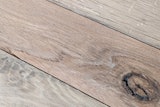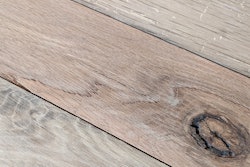
 Without a humidification system, this Midwestern store's flooring split.
Without a humidification system, this Midwestern store's flooring split.
The Issue
A national clothing store remodeled an existing location in the upper Midwest and installed 5/8-inch-by-7-inch engineered white oak flooring. After installation, the GC noticed the floors were split in multiple locations and contacted an inspector, who was surprised to discover the installation company was from Arkansas. The GC explained that national stores typically use the same contractors throughout the U.S. because the store layout doesn't change much.
Roy: The Inspector's Observations
Upon inspection, the floor had multiple face splits ranging from a couple of inches to the entire length of the plank. I obtained several RH readings ranging from 9.9% to 12.6% and MC readings below 5%. A review of the mechanical room found there was no humidification system, although it appeared there had been one previously. The contractor reminded me that every store has the same lighting, shelving, flooring, etc. He went on to say the designer and architect were also from down South and rarely on site.
The wood flooring manufacturer requires a minimum RH of 35%. The specifier said he was aware of the RH parameters but was typically concerned with higher levels due to his geographical location. He didn't think the Midwest could get so dry during winter. My conclusion was that the specifier failed to acknowledge the importance of providing and maintaining proper RH requirements.
Blake: The Attorney's Analysis
The party who hires the architect or other designer "owns" the project design, for good and for bad. The clothing store hired the "specifier" (presumably a design professional) to prepare the plans and specifications to be used throughout the country. This means the GC and subcontractors are entitled to rely on the specifier's plans. Because the clothing store hired the specifier, it is responsible for the cost of any defects or errors in the plans. In turn, the clothing store has claims against the specifier for negligence. The specifier was hired to design stores to be constructed across the nation, which involves many different climates. While the GC or installer had obligations to make sure the RH parameters were in line during installation, any defects or errors in the plans are the specifier's responsibility. The store will need to pay for the flooring to be removed and either reinstall it after adding humidification or switch to a different product. Ultimately, the specifier will be on the hook to compensate the store for the extra costs.
RELATED: The Cause of 'Dry-Cupping' in Engineered Wood Floors


































